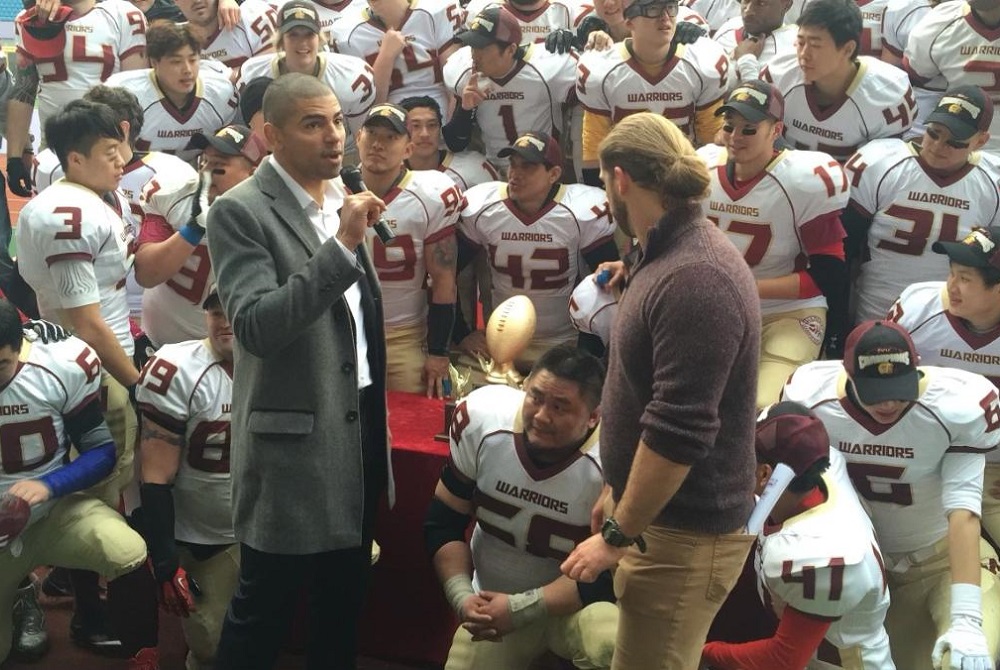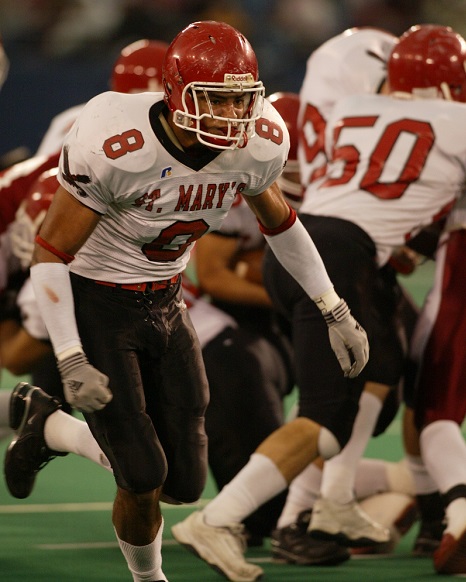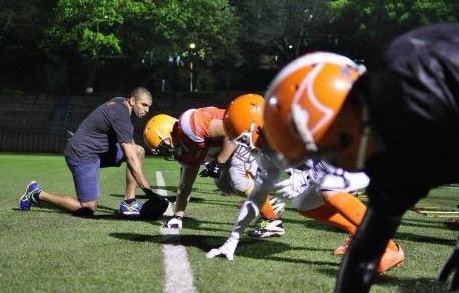
All Eyes on Ithaca's Winning Streak
November 1, 2012
By Geoff Kimmerly
Second Half editor
Terry Hessbrook has sensed this level of buzz around Ithaca's football program once before.
He was a senior running back during the 1984 "dream season" when the team finished the regular season 9-0 and made the playoffs for the first time. The Yellowjackets' postseason run lasted only a week – Ithaca fell to Grand Rapids South Christian 20-0 in the first round, which in those days of shorter playoffs was the Regional Final – but the excitement was reminiscent of the attention his program is getting heading into Friday's Division 6 District Final against Hemlock.
Except this hype extends far outside the city limits of his 2,900-resident hometown. Ithaca has won 38 straight games, the fifth-longest streak in MHSAA football history, and is only three more wins from a third straight trip to the Finals at Ford Field.
“It’s been really neat to have people take a look at what we’re doing in Ithaca,” Hessbrook said. “We’re not doing anything different. We’re not reinventing the wheel. We’re not a bunch of geniuses or anything like that. We just have a coaching staff that works really hard and supports each other, and we don’t care who gets the credit. And the players don’t care who gets the credit.”
How much the ninth-year coach is beaming comes through the phone as he talks of his players' handling of the growing expectations or how fortunate he is to be surrounded by assistants he's been close with, in at least a few cases, for decades.
And winning makes everything more fun. The Yellowjackets get a Second Half High 5 this week as they work toward becoming just the fifth school to win three straight MHSAA titles since the first playoffs were held in 1975. The winning streak is the third-longest among those that included at least one season since the postseason was added.
Ahead of Ithaca on that consecutive wins list are Hudson (72), Morenci (44), Cheboygan (43) and New Lothrop (39). But only Cheboygan accomplished its streak completely within the playoff era, with Hudson’s coming to an end in the first MHSAA Class C Final.
Making this run more special is that half the team has been together for nearly all of it.
Hessbrook brought his players into a huddle at the start of practice this August, and as he started looking at their faces, a thought crossed his mind.
“Wow, you guys have been around for a long time,” he told them.
Ithaca’s football players haven’t been around any longer than those on any other team in Michigan. But it sure feels that way. The Yellowjackets have played in 12 playoff games over the last three years, and five seniors who moved to varsity at the start of 2010 – receiver Markes Gadlen, linebackers Tyler Gibson and Jacob Barnes and linemen Bradley Martyn and Josh Capen – have played in 38 varsity games. That’s the equivalent of more than four regular seasons. And the team's other 12 seniors all came up for the playoffs in 2010, giving them more postseason experience than perhaps any group currently playing in this state.

During that 2010 run, they felt like they were along for the ride. Last season’s championship was about seniors like Garrett Miniard and David Brown showing they could win one too after following all-state quarterback Alex Niznak’s lead the year before. Now, these seniors similarly want to be the leaders of another title run.
But Hessbrook is sure to credit one more group – the 2009 team that played in the team's first MHSAA Semifinal.
“In 2009, that group of players raised the bar, and they made it possible, although they didn’t win,” Hessbrook said. “They didn’t get to the big game. But in 2009, for one quarter (in the Semifinal), we played with Montague (which went on to finish 14-0).
“The bar has been raised. I don’t know that the goal now is to (just) get into the playoffs. I think the kids are hungry enough that they don’t want to just get in. They want to get in and make noise.”
The name statewide observers are coming to know is that of junior quarterback Travis Smith. He took over in the 2011 opener and quarterbacked the team through the 42-14 championship game win over Constantine, throwing for 299 yards – fifth-best all-time for an MHSAA championship game.
His numbers this fall say plenty – 107 completions in 175 attempts for 1,696 yards and 30 touchdowns, with only four interceptions. Smith also leads the team with 610 rushing yards and 12 touchdowns on the ground. He’s 6-foot-2 and 200 pounds and already getting the college looks that came to Niznak during his senior season after he’d already committed to Central Michigan.
Total, the team is outscoring opponents on average 53-6. The defense is a little smaller but faster this fall, and is averaging exactly three turnovers per game.
Another stat helps it all make more sense. Teams submit the grade-point average for their top 11 players for academic all-state – and Ithaca’s group comes in at 3.85.
And visitors to Ithaca don’t get the feel they’re in a small town once they enter the stadium. Recent renovations included the addition of viewing platforms 15 feet above the track that put fans closer to the field than the first row of bleachers. There are new bathrooms and a larger concessions area, but the biggest blast comes from the 13 by 24-foot Jumbotron scoreboard that’s made the stadium feel more like the home of a Division II college team.
Hessbrook estimates at least 2,000 fans are showing up for home games, and similarly large crowds have followed his team on the road.
To Ithaca’s credit, the team is taking all of this in stride. It’s not that the streak isn’t a big deal – “It is what it is,” Hessbrook said – but the players just don’t talk about it too much.
“They’re really a mature group of seniors, really grounded, from great families with great parents who are very supportive of what we’re doing and just keep their kids grounded. The coaching staff does a good job keeping the kids grounded," Hessbrook said. "You’re only as good as your last game. Nobody’s going to care what you did last week or last month. And I think the players believe that.”
PHOTOS: (Top) Ithaca's Caden Kipp and Zach Allen (12) celebrate after a touchdown during last week's win over Grandville Calvin Christian. (Middle) Quarterback Travis Smith already is in the MHSAA record book for his performance during last season's Division 6 Final. (Click to see more from HighSchoolSportsScene.com).

St. Mary's Standout McLaurin Becomes Chinese Football Pioneer
By
Tom Markowski
Special for Second Half
August 19, 2021
The eight years Chris McLaurin spent in China not only changed his life, but they changed the perception of American football in China and elsewhere – and just may have opened the door to a whole new market.
 We're talking “American football,” not soccer. Most of us are familiar with NFL Europe, but NFL China? Not so much.
We're talking “American football,” not soccer. Most of us are familiar with NFL Europe, but NFL China? Not so much.
When McLaurin went to China in 2011, the thought of teaching the locals American football never occurred to him. He went there to work for a private company, and circumstances just seemed to fall in place.
Some might say McLaurin was in the right place at the right time, but it can also be said he was the right person at the right time to lead this undertaking. McLaurin had the background, both athletically and organizationally, to take on such an endeavor.
“I met a lot of people who were interested in football,” McLaurin said. “I thought, football? I had a limited understanding of what they knew. I was very surprised they would reach out to me. I quickly found out they were hungry to learn.”
A 2005 graduate of Orchard Lake St. Mary's, McLaurin started at tight end and linebacker, and helped the Eaglets reach the MHSAA Division 2 Final in 2004 (where they lost to Muskegon). McLaurin went on to play four seasons at Michigan and graduated in 2009 with a degree in history and minor in urban and community studies. He had thoughts of entering law school when other opportunities interceded.
During his time in Ann Arbor, McLaurin worked with an organization that focused on disadvantaged youth in the area and helped open doors for them. They were allowed to attend lectures at the university as well as sporting events.
Upon graduation, the seeds that would blossom in Asia began being sown in other parts of the world.
McLaurin received a Fulbright Scholarship and went to Johannesburg, South Africa, to work with underprivileged youth as part of a program called Tomorrow Trust. During this time he worked with the United Nations Development Programme and Harvard Law School in their pursuit of promoting economic rights for the poor.
Following his work in South Africa, McLaurin began his post-graduate work at the London School of Economics. He earned his degree after working in the House of Commons and as a research assistant for the Runnymede Trust. Then came a six-month internship within the Obama Administration as part of the White House Domestic Policy Council.
And after that, he was off to Chongqing in western China to work for a private equity company as a project manager. Two years later, he started his own company in addition to a non-profit organization. Much of his work centered on the automobile industry and global technology.
During this time he learned to speak Mandarin and, in doing so, was introduced to more of the local customs – including American football.
 What McLaurin found was a rudimental brand of football, what we would term a recreational type of competition. McLaurin began his involvement gradually, on weekends.
What McLaurin found was a rudimental brand of football, what we would term a recreational type of competition. McLaurin began his involvement gradually, on weekends.
“After that first year (2012), I took it up a notch,” McLaurin said. “We started recruiting players and bought new equipment. They watched football on TV, but it's not an easy game to understand. You have to play football to learn it. You don't get that from watching TV.”
A year of training, recruiting and, yes, some frustration, led McLaurin to start a league, the American Football League of China (now known as the China National Football League). The rules are similar to those at the U.S. college level. There are 11 players a side, and when a ball carrier's knee touches the ground the play is over.
In the beginning “it was successful,” he said. “There were no leagues when I got there. There was no one to organize it. We went from (fewer than) 10 teams to, 3-to-4 years later, there are 80-90.”
McLaurin quickly learned he needed help if this adventure was to succeed. USA Football had a footprint in Shanghai, and McLaurin reached out to the organization. McLaurin contacted a handful of former teammates including Prescott Burgess and Morgan Trent for advice. Former NFL player Bruce Plummer and NFL coach and scout Jerry Hardaway worked some of the camps and clinics with McLaurin and added much-needed experience and expertise.
After playing at Southern Illinois, Hardaway’s first coaching position was at Memphis State as an assistant, and then he went to Grambling State to coach under the legendary Eddie Robison for six seasons. He also coached at the University of California under Joe Kapp prior to working in the NFL and then heading to China.
“I was told, through another guy, that (McLaurin) needed some help,” Hardaway said. “It was all about getting back to basics. That's what made it fun. They had no clue when you'd say to them, control the ground at impact when you're making a block. They had no idea of the terms that you'd use. To see the young kids, to see on their faces, they were absorbing everything.
 “Yes, yes, yes, it was worthwhile. First of all, people had no clue about what it takes to do something like this. They were learning. Some of the parents thought it was a violent sport. That's what they heard. Then they switched. They saw me, us, teach the basics and they saw what we were doing. For me, it gave me a sense, like hey, you have to teach and you have to enjoy it.”
“Yes, yes, yes, it was worthwhile. First of all, people had no clue about what it takes to do something like this. They were learning. Some of the parents thought it was a violent sport. That's what they heard. Then they switched. They saw me, us, teach the basics and they saw what we were doing. For me, it gave me a sense, like hey, you have to teach and you have to enjoy it.”
Soon after that first season, the NFL got involved as did the National Committee on United States - China Relations. McLaurin credits the NFL for advising him on the business end of starting a new league and structuring. After 18 months, McLaurin got out of coaching and became the commissioner.
“(The NFL) wanted to expand,” he said. “They saw how their brand was quite low (in China). China is a natural.”
Progress was slow, but it was still progress. The 2015 championship game was played in Shanghai, and McLaurin estimates it drew 3,500 spectators.
He continued to work with the AFLC through 2019 but then decided to make a career move. He returned to the U.S. and, this fall, is pursuing a dream he's held since leaving U-M. At age 34, McLaurin entered Harvard Law School.
“When I started, the last thing we wanted was a U.S. version of football,” he said. “We wanted it to be Chinese football. There were limitations on how many foreigners would compete. At first it was five (per team), then three. We wanted it to be a Chinese experience."
2020-21 Made in Michigan
August 5: Herremans' Focus on 'Dadding,' Giving Kids Similar Small-Town Childhood - Read
July 29: Loy Norrix Career Prepped Crocker for U-M Success, Law Degree Pursuit - Read
July 19: Top PGA Pro Finish Latest Greatest Highlight as Cook Continues Climb - Read
July 16: TC West Standout Renews Ties to Titans, Cheers Past Teammates' Gold Pursuit - Read
July 8: Caro Champs Find Common Ground Again as Mental Health Providers - Read
June 28: Michigan's Minor Leaguers Making Up for Lost Season - Read
PHOTOS: (Top) Former Orchard Lake St. Mary's standout Chris McLaurin started an American football league in China and remained part of its leadership through 2019. (Middle) McLaurin was a two-way starter for St. Mary's 2004 Division 2 runner-up team. (Below) McLaurin runs drills for one of the Chinese teams. (Top and below photos courtesy of Chris McLaurin; middle photo from MHSAA archives.)

